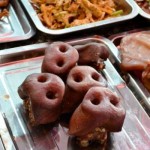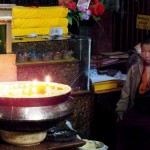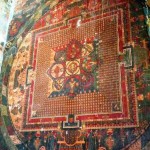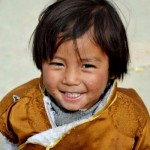Seven days in Tibet – episode 4
GYANGZE
We start to Gyangze, dressed with our white scarves named khata, offered by the hosts together with wishes of good luck and farewell. Tradition for the tourists is that you have to leave scarves on the temples, stupas, wherever you feel the vibration that could make life more beautiful by offering to. I forgot to do that, next time.
We make a stop at an old mill on a river side, where for a bill, an old man show us how to grind the barley using stone wheels. We taste the mentioned cereals that seems to be expanded, however, alternative to pop-corn flour.
Here we arrive in Gyangze. The hotel welcomes us with the well-known Tashidelek, reception that somewhat compensates the few stars less than the diorama of Shigatse. The city reveals some well-preserved of Tibet. The Palkhor Complex, with its spectacular stupa temple, promises to us we can breathe a little Buddhism. However, I look with envy at the monasteries perched on the slopes of the mountains surrounding the city. It seems to be some little houses, but my tele camera reveals buildings with six, even seven floors. I see no way to access them. Oh, I think you can get there a good pulse of the past in this dying patient’s chart. Another thing that remains to be done during the next visit.
Palkhor Site is truly impressive, with a history that starts in the fifteenth century. The Kumbum, largest stupa of this kind in Tibet, houses in the nine floors its 76 chapels and shrines, where you can enter through the 108 richly decorated gates. The first five levels are square, the rest are circular, which gives the look of one pyramid. It’s actually a three-dimensional mandala. Ascending into the spiral from left to right, you can see all the 100,000 representations of the Buddha, painted or carved, and reached the top, the whole Gyangze is laid out at your feet. The feeling is still the humble, because the eyes of Buddha look carefully in your consciousness wherever you try to hide them.
Besides, the temple Tsulaklakang, impresses by the multitude of statues of Buddha Shakyamuni– Present (8m height), Buddha Maitreya – Future of the old kings, many Tara, the former Dalai Lamas, and three-dimensional models of mandalas, bronze or butter. The chapels host also manuscripts of the sacred texts, written in gold on black rectangular piece of paper, soaked in poisons to protect them from rodents, unbound, but carefully wrapped in stacks in black canvas. Writing is unreadable even for our Tibetan guide. I am surprised to observe rituals and symbols that I know already, such as passing under the holy books, even for the Orthodox these have another meaning. Various representations of the cross, Star of David, swastika, Hindu gods, all these reinforce my view that Buddhism is not just a religion easily understandable.
- Șapte zile în Tibet – Gyangze
- Șapte zile în Tibet – Gyangze
- Șapte zile în Tibet – Gyangze
- Șapte zile în Tibet – Gyangze
- Șapte zile în Tibet – Gyangze
- Șapte zile în Tibet – Gyangze
The main hall with 48 columns decorated with silk tankha, ring of the mantras uttered by Gelukpa monks, those with yellow caps, that meditate. This murmur lighted in the colorful light of the tubular silk umbrellas, sweet smell of sandalwood burned and the stench of yak fat from votive lamps, remember me for few minutes the well-being they I am looking for a place like this. Who has time to notice that some monks make calls on mobile phones or count their money? We found what we seek. An uplifting experience so you can’t end otherwise than on the roof of the temple, close to all-seeing eyes of Buddha. It is surrounded by a red wall and a very high, white wall on which are exhibited the big Thankas during the Yogurt Festival, carefully preserved in chapels.
The Dzong in Gyangze is visible from almost anywhere in the city. So, we must be satisfied only with this, because the Anti-Imperialist British Museum that it hosts – is closed.
On streets we always find one child having the warmest and most sincere smile, to be a silent guide for us … for candies. Walking elsewhere, we get in the local “mall”, where you can buy a HTE phone or other “original” goods. The market is also “a must” if you want to see how live and mostly what eat people among how you are. From the dozens of bags with spices, rice pasta, ready cut vegetables, dried wood ears, to delicacies as deep fried chicken claws until crispy, yak belly like dirty towels or delicious roasted pork mouth. Of course, the yak meat is the market’s primadonna, an acknowledge after fur pieces here and there left on the hunk of meat, testament to the origin species. No way that is not fresh, you can see how just butcher brings, hanging one bike spokes. And especially dogs would struggle to rise in two feet on the stands, if is it not worth? In addition, no bite wings. Leaving from the market toward a restaurant, thinking of a fried rice with, you guessed it, yak meat.
- Șapte zile în Tibet – Gyangze
- Șapte zile în Tibet – Gyangze
- Șapte zile în Tibet – Gyangze
- Șapte zile în Tibet – Gyangze
- Șapte zile în Tibet – Gyangze
- Șapte zile în Tibet – Gyangze
- Șapte zile în Tibet – Gyangze
In the evening, Răzvan decides to let his hair in Gyangze. Surprisingly, we find a quite fancy hair salon. While he restyles himself, under the eyes of a lady in a Channel jacket, a little girl is trying to cut her nails with a nail scissors hanging. I, foreseeing the danger, as a responsible adult, rather jump to … take pictures. Răzvan’s experience ends with a quite expensive bill, but with an unrepeatable “Gyangze look”.






















imi place sa ma uit la ambele variante…pentru poze mai multe.templele de pe dealuri arata minunat si te ademenesc…